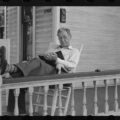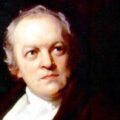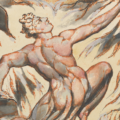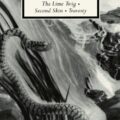Out of Body: Reading Gender Through “Women’s Fiction”
It was a book my two boys wanted me to read to them over and over again: the story of how Mike Mulligan and his steam shovel, Mary Ann, dug the basement of the new town hall in a single day, only to find that they had trapped themselves inside the resulting hole. But, as it turned out, Mike Mulligan was a man who could make a virtue of digging himself into a hole. It had been a favorite of mine as a child, but as a stay-at-home father I found that Mike Mulligan and His Steam Shovel held new and deeper meanings.
As a young woman, the author, Virginia Lee Burton, had been preparing to leave home to join a ballet company when her father became seriously ill. As was expected of a dutiful daughter, Virginia set aside her plans in order to stay at home and nurse her father back to health. While she was at home, she began to take art classes, and discovered she had a talent for illustration. She eventually married and had two sons, who inspired her to write and illustrate a handful of classic books for children.
As someone who set aside a career to stay at home with children, Virginia Lee Burton became a role model: a talented and intelligent woman who had found a golden opportunity in an unexpected change of course. And Mike Mulligan and His Steam Shovel turned that experience into a perfect fable of male domesticity. At the end of the story, Mike Mulligan graciously accepts his place beside a domestic hearth as his steam shovel is converted into the furnace of the new town hall. He becomes a kind of homemaker, sitting at the center of a network of personal relationships. Children love him, women bring him pies, he’s faithful to his Mary Ann.
Being immersed in the daily life of a stay-at-home father, in what most people still considered women’s work, had changed how I read.
Before third grade, I wasn’t much of a reader. I spent most of that year contriving ways to be sent to the principal’s office. If I was assigned to water the plants in the classroom, I pretended to trip on my shoelaces and spilled water on the floor. If the teacher showed a film in class, I found a way to bump into the projector and send the film leaping off the screen. My first clear memory of myself as a reader was in my encounter with the book Pippi Longstocking. Like me, Pippi was red-headed, freckled, high-spirited, and mischievous. She was also several things that I was not. She was strong, self-confident, and independent. She had no principal, no parents or teachers to tell her what to do. She lived a life of adventure. She was a girl.
In fourth grade, my behavior improved dramatically. It was the year I started to write. I spent hours writing adventure stories, imagining myself on a whaling ship wandering the seas, or in the lawlessness of the Old West, so that when I think of fourth grade I remember the salt swells and the dry canyons as clearly as I remember the classroom where I sat and wrote. I had learned that to push against the constraints of the real world, I didn’t need to get myself dragged, literally kicking and screaming, to the principal’s office. I didn’t need to act out. I could sit quietly and imagine.
In 1992, I was twenty-eight, married to a young professor. Like my wife, I had earned a Ph.D. in classics, but with the birth of our first son I had left behind a career as a classicist. It seemed natural, in some ways. Both my mother and my maternal grandmother had also left teaching careers to get married and raise a family. My grandmother was married in 1921, when teaching was a profession for unmarried women. She became a housewife, raised two sons and a daughter, volunteered in her church and community, and died on her kitchen floor. Seventy years after my grandmother ended her teaching career to become a homemaker, I found myself, forebodingly perhaps, embarking on a similar path.
Early in my years as a stay-at-home father, I was browsing in one of the used bookstores downtown when I paused to pull an attractive green paperback from the shelf. The book was The Way Things Are, by E.M. Delafield. Above the author’s name on the cover of the book were the words “Virago Modern Classics.” As a classicist, I am immediately intrigued by anything that called itself a “classic,” so I bought the book and, during the boys’ naps, started to read. The novel, first published in 1927, was about an ordinary woman’s life: her struggles to raise her children and run a household and interact with a husband who disappeared behind a newspaper every evening; her longings and her frustrations and her attempts to reconcile herself to the way things are. Laura’s life was not exactly my own—my children were just as much work, but my spouse was a sympathetic partner in that work—but it very well might have been my grandmother’s life in the 1920s, and I was connected to it by a fine thread of dailiness and domesticity.
After The Way Things Are, I began to search the shelves of the local used book stores for more Virago Modern Classics. At one of the shops on Division Street, I found a peculiarity in the shelving system: there was a section labeled CLASSICS, and a separate section labeled OLDER FICTION. Most of the authors in the Classics section were men, with a few well-known women thrown in—Jane Austen, George Eliot, the Brontës, Virginia Woolf. The Virago Modern Classics were shelved in the OLDER FICTION section.
I asked Dick, the owner, about this peculiar arrangement. Why, for example, was William Faulkner (the Nobel Prize winner in 1949) shelved among the Classics, but Ellen Glasgow (the Pulitzer Prize winner in 1942) shelved among Older Fiction? Was it that men became classics and women just became old? Or, not to make a gender issue out of it, why was Virginia Woolf a Classic, but May Sinclair, who first applied the term “stream of consciousness” to fiction, simply Older?
“I own the store,” Dick said, “so I decide how things are shelved.”
The shelving in Dick’s book shop—and his attitude—reflects a familiar situation in literary culture. In her ground-breaking 1977 study, A Literature of Their Own, Elaine Showalter observed that the conservatism of the literary canon “reduced and condensed the extraordinary range and diversity of English women novelists to a tiny band of the ‘great’”— specifically, Austen, the Brontës, Eliot and Woolf. Scholars and ordinary readers had “lost sight of the minor novelists, who were the links in the chain that bound one generation to the next.” Hundreds of women writers had gone out of print or were otherwise waiting to be rediscovered—novelists like Rose Macaulay, Elizabeth Taylor, Antonia White, Barbara Comyns, Sylvia Townsend Warner, E. Arnot Robertson, Elizabeth Jenkins, F.M. Mayor, Kate O’Brien, Rebecca West, and Winifred Holtby. Then in 1978, motivated by the challenge of Showalter’s book, Carmen Callil founded an independent publishing company devoted to rediscovering neglected women writers, which she named Virago Press. Callil recalls:
I remember my ambitions clearly. I started Virago to break a silence, to make women’s voices heard, to tell women’s stories, my story and theirs. How often I remember sitting at dinner tables in the 1960s, the men talking to each other about serious matters, the women sitting quietly like decorated lumps of sugar. I remember one such occasion when I raised my fist, banged the table and shouted: “I have views on Bangladesh too!”
As a young stay-at-home father, I gravitated toward Virago Modern Classics because they illuminated the ordinary domestic life to which I was growing accustomed, without becoming sentimental or losing sight of the broader human concerns and higher aspirations of their female characters. For most of the history of the English novel, writing was one of the only occupations open to women, one of the only ways in which they could make their voices heard outside the nursery and the kitchen. Their writing can’t help but express the immense gulf between the expansiveness of their imaginations and the apparent narrowness of the sphere to which they were traditionally confined. But being confined to that sphere, the sphere of domesticity, they also couldn’t help looking around and seeing some of its homely significance. They couldn’t help seeing that this world of messy children and dirty floors, of broken cookers and tight household finances, was also the real world. More real, perhaps, than anything else.
One of my favorite authors represented in the Virago Modern Classics is Elizabeth Taylor (1912–1975). I discovered her in the mid-1990s, when I read her second novel, Palladian. The novel is about a young woman named Cassandra Dashwood, who is engaged as governess to the daughter of a man named Marion Vanbrugh, a classicist (oddly enough) who inhabits a crumbling Palladian mansion. I loved the novel for its literary echoes (especially of Jane Austen, Charlotte Brontë, and George Eliot), and for the way it blended and undercut this self-conscious literariness with straightforward realism. A major theme that runs through Taylor’s early novels is the tension between the life of the imagination and the mundanity of the real world. Taylor is interested in how we see life through what we read, and how literature at the same time provides an inadequate substitute for life itself. Her novels are shaped as much by the Great Tradition in literature as the daily realities of domestic lives.
Taylor was born in Reading, attended the Abbey School (as did, more than a century earlier, Jane Austen), and worked as a governess and librarian before marrying a businessman and settling down for the rest of her life as a housewife in Penn, Buckinghamshire. She raised two children, who must have been quite young when she wrote her first novel, and seems to have enjoyed hanging out the laundry.
In her novel Angel, the title character has become a successful romance novelist, writing novels that have very little relation to real life. Her poor mother, Mrs. Deverell, has been forced to leave behind her familiar cramped shop in town to live an idle life in Angel’s large suburban home:
At a time of her life when she needed the security of familiar things, these were put beyond her reach. It seemed to her that she had wasted her years acquiring a skill which in the end was of no use to her; her weather-eye for a good drying day; her careful ear for judging the gentle singing sound of meat roasting in the oven; her touch for the freshness of bacon; and how, by smelling a cake, she could tell if it were baked: arts, which had taken so long to perfect, now fell into disuse. She would never again, she grieved, gather up a great fragrant line of washing in her arms to carry indoors… The smell of ironing being done or the sound of eggs being whisked set up a restlessness which she could scarcely control.
In the background of this, I catch a glimpse of Taylor herself, the successful novelist, determinedly holding onto her ordinary life—the raising of her children, the drying of laundry, the middle-class anonymity of a Home County businessman’s wife. She kept herself rooted in what was real from day to day. All of this (the erudite literary references and the grounding in dailiness) had an immense appeal for me. Elizabeth Taylor seemed like a kindred spirit: someone who had read and appreciated Middlemarch, but who also knew what it was like to rinse out diapers in the toilet.
“Half the world scrubbing on their knees,” says a character in Palladian, “the other half sitting on its arse.” It’s a comment on class differences in its original context, but it also describes the difference between the housewife and the reader and writer: two halves of the world embodied in Elizabeth Taylor herself, the novelist and homemaker. It’s also an allusion to Jane Austen’s Emma, who said that “one half of the world cannot understand the pleasures of the other.”
Reading is vitally important for many of the female characters in Virago Modern Classics. It opens up for them a world of the imagination, and gives them a sense of being connected to the lives of others. Conversely, non-readers often lack the empathy that allows them to make a connection with the real lives of others. In E.H. Young’s The Curate’s Wife, for example, a self-important and unsympathetic women named Mrs. Doubleday hears a young woman mention Lady Catherine de Burgh, and assumes that Lady Catherine is a real person, some wealthy country relative of the young woman. Mrs. Doubleday has little empathy for other people, and her lack of empathy goes hand in hand with the fact that she isn’t a reader of novels.
Reading, for me, is an out-of-body experience in which I find myself lifted from my (male) body into the thoughts and life of a (typically female) protagonist. For a brief period, I become her: I experience the life of a housewife in the 1920s, a little girl in an English convent school, a teenage girl in the 1940s falling in love for the first time. But at the same time, I’m still myself, and the book allows me to reach out and make a meaningful connection with another human life. Reading is doubly an out-of-body experience, because I am disembodied as a reader and she—the novelist, the narrator—exists for me not as a body, but as words on a page and in my mind. The novel frames a shared subjectivity, and gives the male reader and the female novelist a common voice. This voice, this imaginative cohabiting of a domestic space, this enlarged empathy—these aspects of reading fiction by women have helped me to shape an ethics of care which is attentive to different voices and responsive to the connections between individuals.
But imagination and empathy—the qualities fostered in solitude by the act of reading—are not enough without some real connection to the world around us. There is a danger that we might read too much, that we might substitute the printed world for the real world. Lurking in the back of Elizabeth Taylor’s early novels is the figure of Mr. Casaubon from George Eliot’s Middlemarch—the arid scholar isolated among his books who fails to engage with the world. In Taylor’s third novel, A View from the Harbour, one of the main characters is a novelist named, significantly, Beth Cazabon, who is so caught up in her own writing that she often loses her connection with the life around her. As a foil for Beth, there’s old Mrs. Bracey, who refuses to have library books in her house. To Mrs. Bracey, books represent “the little dead worlds of other people’s make-believe, the antithesis of life.” When she falls ill, and the local curate brings her library books, she refuses them. She points out the window and says, “That’s my book.”
The Casaubon dilemma—the problem of connecting reading and imagination to the real world—has occured through much of my reading in the Virago Modern Classics. In Henry Handel Richardson’s The Getting of Wisdom (1902), the main character is a boarder in an Australian girls’ school. She’s an avid reader with a vivid imagination, but she can’t figure out how to fit in with her peers. Her imagination leads her into elaborate lies that only further alienate her from the other girls. In Nadine Gordimer’s first novel, The Lying Days (1953), the narrator, a university student in Johannesburg, finds herself estranged from her homeland, unable to imagine the lives of black South Africans. In Daphne du Maurier’s The Infernal World of Branwell Brontë (1960), the Brontë sisters’ gifted older brother loses himself in the imaginary childhood world of Angria. In Antonia White’s Frost in May (1933), a little girl’s tragedy turns on an act of the imagination. The examples could go on.
The idea that reading novels can and should have a moral effect—that it activates the reader’s sympathies and inspires her or him to more altruistic action—was important to the Victorians, who produced so many massive and morally ponderous novels. Middlemarch is a central text in this moral program. “Moral concern for her characters is the very essence of George Eliot,” wrote Lettice Cooper, who was herself the author of two novels published as Virago Modern Classics. What moved Cooper in Middlemarch was Eliot’s “profound compassion” for the ordinary people, “people of moderate gifts and mixed faults and virtues,” who populate the novel. This compassion for ordinariness is a hallmark of so many of the novels published as Virago Modern Classics. For example, E.M. Delafield’s The Way Things Are, the first Virago I read, ends with Laura’s acceptance of the fact that she is “an average woman.” So many of these novels trace a woman’s growing self-awareness, her growing acceptance of both her abilities and her limitations, and the growth of her sympathetic relationship to the lives of those around her.
When I returned to Middlemarch after more than twenty years, I found in the story of Dorothea Brooke the spirit of a Virago Modern Classic inhabiting the body of a four-volume Victorian novel. As Suzanne Keen writes, Middlemarch “articulated a project for the cultivation of the reader’s sympathetic imagination. Novel readers might learn, by extending themselves into the experiences, motives, and emotions of fictional characters, to sympathize with real others in their everyday lives.” But Keen argues that there is a significant difference between experiencing empathy as a temporary aesthetic response to a novel, and translating that empathy into altruistic action in real life. That process, if it happens, is a gradual one. In the words of philosopher Martha Nussbaum: “Certain ideas about others may be grasped for a time and yet not be acted upon, so powerful are the forces of habit and entrenched structures of privilege and convention. Nonetheless, the artistic form makes its spectator perceive, for a time, the invisible people of their world—at least a beginning of social justice.”
Maryanne Wolf, who examines reading in the context of brain development and function, sees reading and life as part of a mutually reinforcing process of intellectual development. Speaking of her own experience of rereading Middlemarch and finding that she felt new and unexpected empathy for Mr. Casaubon, she says confidently: “Reading changes our lives, and our lives change our reading.” Reading enlarges our experience by placing us into the lives of fictional characters, but our own life experience in turn increases—or changes entirely—our understanding of those fictional lives. “Sometimes we emerge after this immersion into other worlds of thought,” Wolf writes, “with an expansion of our capacity to think, feel and act in new and courageous ways….” She shows the careful and critical rereading informed by life experience involves a complex array of functions in the brain. “By using many parts of the brain,” she argues,” the expert reader is living testimony to our continuously expanding intellectual evolution.”
Middlemarch itself follows the gradual evolution of Dorothea Brooke’s sympathetic understanding, her deepening sense of empathy. Near the end of the novel, Eliot writes: “[A]ll this vivid sympathetic experience returned to her now as a power: it asserted itself as acquired knowledge asserts itself and will not let us see as we saw in the day of our ignorance.”
Feminist critics have often objected to Dorothea because, after asserting her maturity and power as a woman, she becomes a wife and mother. In Sexual Politics, for example, Kate Millett writes: “[Eliot] stuck with the Ruskinian service ethic and the pervasive Victorian fantasy of the good woman who goes down into Samaria and rescues the fallen man—nurse, guide, mother, adjunct of the race. Dorothea’s predicament in Middlemarch is an eloquent plea that a fine mind be allowed an occupation; but it goes no further than petition. She marries Will Ladislaw and can expect no more of life than the discovery of a good companion whom she can serve as secretary.”
Eliot herself anticipated this criticism. “Many who knew her,” she writes of Dorothea, “thought it a pity that so substantive and rare a creature should have been absorbed into the life of another, and be only known in a certain circle as a wife and mother. But no one stated exactly what else that was in her power she ought rather to have done….” Eliot, though she was able to choose a different life, was keenly aware of the limitations placed on women in Victorian society. And she was ambivalent about the alternatives. Her letters, for example, reveal a brilliant and independent-minded woman who signs herself “Mrs. M.E. Lewes,” and who has strong maternal feelings. Although she moved as an intellectual equal in a world dominated by men, Eliot found value in the traditional sphere of women, in what she saw as women’s greater sympathy, care, and sense of justice. Perhaps, she implies, feminism shouldn’t only be about women gaining an equal footing with men in the traditional spheres of public activity. Perhaps it should also be about valuing what women have always done, such as raising children and making a home, and perhaps even making those traditionally feminine activities available to men in equal measure.
In 1924, the novelist and educator Dorothy Canfield Fisher published The Home-Maker, a novel about a wife with a head for business and a husband with a bent toward domesticity. An accident that leaves Lester Knapp in a wheelchair—a symbolic emasculation—allows his wife Evangeline to become the family wage earner while he remains at home caring for their children. Evangeline prefers to read trade journals, and feels a sense of enlargement when she steps into her office. Lester prefers poetry, and feels spiritually diminished away from his home and children.
Being at home gives Lester an opportunity to reflect on the culture of rampant consumerism from which his domesticity seems like an act of treason. He feels the weight of the expectation “that men are in the world to get possessions, to create material things, to sell them, to buy them, to transport them, above all to stimulate to a fever-heat the desire for them in all human beings.” He realizes that in this culture, “men are of worth in so far as they achieve that sort of material success, and worthless if they do not.” He concludes that the “feminists were right, after all”:
Under its greasy camouflage of chilvalry, society is really based on a contempt for women’s work in the home. The only women who were paid, either in human respect or in money, were women who gave up their traditional job of creating harmony out of human relationships and did something really useful, bought or sold or created material objects. As for any man’s giving his personality to the women’s work of trying to draw out of children the best there might be in them … fiddling foolishness!
Lester sees that while feminism had enhanced the position of women in society, it had done so on terms dictated by men. Traditional male work—the work of commerce and industry, making and selling—was assigned value, and enhanced the value of women. Traditional women’s work—the work of housekeeping and caring for children—remained undervalued, and reduced the value of men who participated in that work.
The challenge, apparent to Dorothy Canfield Fisher and George Eliot, as well as many feminists in the decades since then, was not simply to give women access to work, and to the related power and prestige traditionally reserved for men. It was also to allow men, without loss of status or self-esteem, to fill the nurturing roles that had long been filled almost exclusively by women. In her perceptive biography of Eliot, Jenny Uglow writes:
The message for the lives of women seems to be that although change must come (preferably gradually rather than suddenly), it must not be at the expense of traditional female values. Although it is wrong for women to be excluded from access to common culture and common stores of power, they should demand them for the sake of partnership with men and for the good of society, not just for their own separate fulfillment… The vital thing is not to launch women into a masculine sphere, but to “feminise” men, because the feminine strengths have for so long been trampled underfoot and undervalued.
A hundred and thirty years after George Eliot wrote about Dorothea and Mr. Casaubon, I was a homemaker with two young children, and my wife was a professor of Latin and Greek, and our marriage was the kind of partnership that Eliot envisioned. The women that I read about in novels were part of my own history. Wolf was right. My role as a stay-at-home father has changed my reading—it deepened my identification with female characters in the midst of their own domestic lives—and my reading has changed the way I looked at my own life.
Early in Middlemarch, Dorothea aspires to arrive at “the core of things” through Mr. Casaubon’s scholarship. There is a distant echo of this aspiration in Barbara Pym’s No Fond Return of Love. Early in that novel, Dulcie Mainwaring, an academic indexer, is attending a conference when she finds herself imagining better uses of her time:
But there is more satisfaction in scrubbing a floor or digging a garden, Dulcie thought. One seems nearer to the heart of things doing menial tasks than in making the most perfect index. Again her thoughts wandered to her home and all that needed to be done there, and she began to wonder why she had come to the conference when she had so many better ways of occupying her time.
An index allows a reader to find a place in the text. Domesticity allows Dulcie to find her place in real life. Scrubbing the floor is not heroic, but it has to be done.
The late Oxford scholar A.D. Nuttall writes of Middlemarch: “The slow accumulation of asphyxiating, counter-heroic ordinariness in nineteenth-century middle-class life has produced, very naturally, a nineteenth-century three-decker novel ending in marriage and a baby.” My own experience has brought me to a very different appreciation of the novel. I would argue that Middlemarch celebrates that “counter-heroic ordinariness” as much as it finds it suffocating.
Carol Shields begins her last novel, Unless, with an epigram from Middlemarch: “If we had a keen vision and feeling of all ordinary human life, it would be like hearing the grass grow and the squirrel’s heart beat, and we should die of the roar that lies on the other side of silence.” Shields’s novel is not about large statements, but the small grammar of experience that make a coherent narrative of our lives. It’s about loss and healing, and about the cracks in an ordinary life through which we sometimes catch an echo of the roar that lies beneath. The insight of so many women novelists from George Eliot to Carol Shields, as well as many feminist activists, is that ordinary life is not at all “counter-heroic.” There is real value in raising children, in coping with loss, in holding together a marriage, in buying the flowers oneself, and in holding up against the deadening roar that occasionally reaches our ears. The great variety of authors who have written about these experiences, whom Showalter illuminated almost four decades ago, have yet to be brought fully into the canon, or placed in the Classic section of old bookstores—but it is time.
Here I stopped writing to fold laundry down in the basement, while upstairs my wife sat and worked on a scholarly article. Which one of us was closer to “the core of things”? Perhaps the core of things is simply the common center we make for ourselves, around which our lives revolve together.
About Rob Hardy
Rob Hardy has been a stay-at-home father, a teacher, a researcher for The Writers’ Almanac, a school board member, and an adult advisor to the Northfield Skateboard Coalition. His essays have appeared in New England Review, North Dakota Quarterly, New Letters, and other literary and scholarly journals. His poetry has appeared in literary journals, and has been stamped onto the sidewalks of Northfield, Minnesota. His translations and adaptations of Greek tragedy have been staged at Carleton College, where he’s currently a visiting assistant professor of classics.






